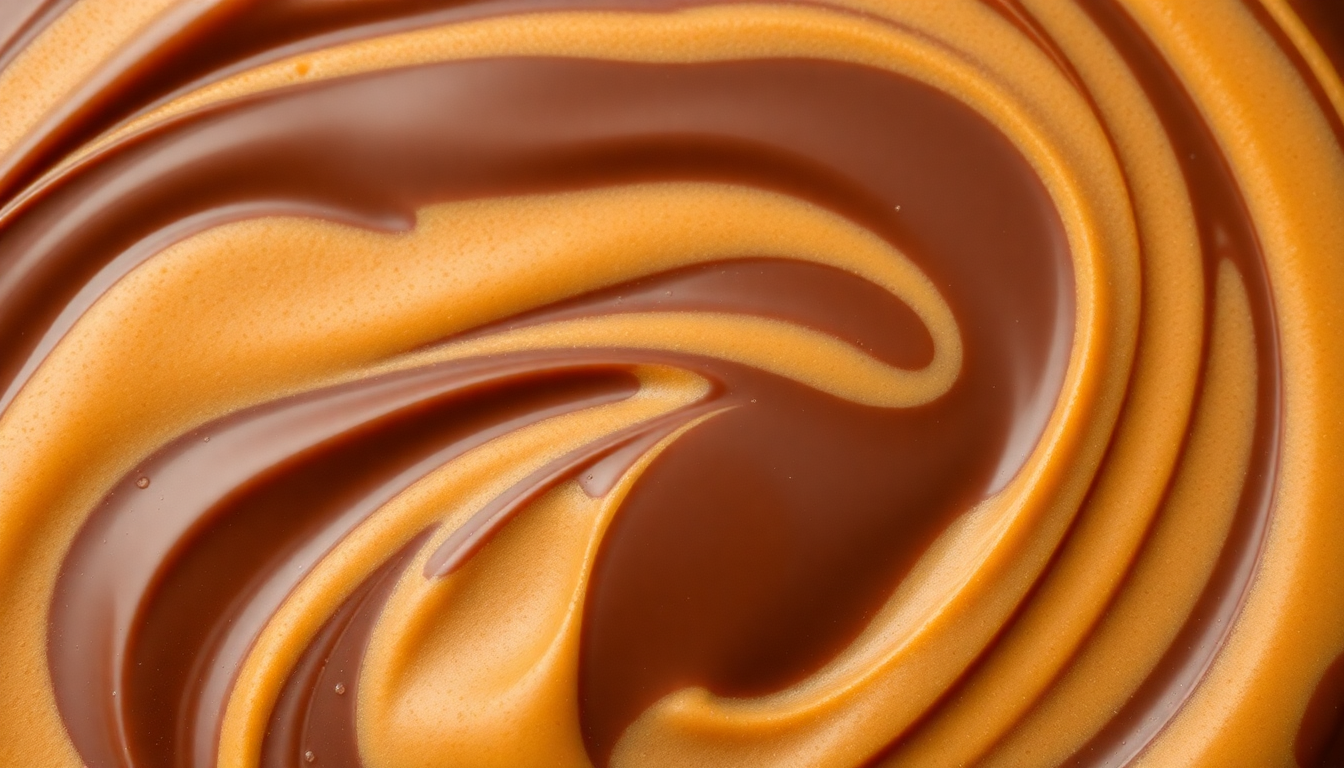
Peanut Butter and Chocolate: A Perfect Match
Introduction
Few flavor combinations have achieved the iconic status of peanut butter and chocolate. This dynamic duo has captured the hearts and taste buds of dessert enthusiasts worldwide, creating a flavor profile that's simultaneously rich, creamy, sweet, and slightly salty. From classic peanut butter cups to elaborate cakes, this pairing continues to inspire culinary creativity and evoke nostalgic comfort. The marriage of smooth, nutty peanut butter with decadent, sweet chocolate creates a sensory experience that satisfies multiple flavor cravings at once. This enduring combination isn't just delicious by chance—there's actual food science behind why these two ingredients complement each other so perfectly. In this comprehensive guide, we'll explore the history, science, and versatility of the peanut butter and chocolate combination, along with mouthwatering recipes you can create at home.
The Science Behind the Perfect Pairing
Complementary Flavor Profiles
The magic of peanut butter and chocolate lies in their contrasting yet harmonious flavor profiles. Chocolate, particularly dark varieties, offers a complex bitter-sweet taste with fruity, floral, and earthy notes depending on its origin and processing. Peanut butter contributes a rich nuttiness with savory, slightly salty undertones. This creates a perfect balance—the sweetness of chocolate tempers the saltiness of peanut butter, while the nuttiness of peanut butter enhances chocolate's depth and prevents it from becoming too overwhelming.
Texture Harmony
Beyond flavor, the textural interplay between chocolate and peanut butter creates a multidimensional eating experience. The smooth, melting quality of chocolate pairs beautifully with the thick, creamy consistency of peanut butter. When combined in various desserts, they can create everything from velvety ganaches to crunchy cookie bits, offering an array of textural possibilities that keep our palates engaged.
The Fat Factor
Both ingredients contain significant amounts of fat—cocoa butter in chocolate and natural oils in peanut butter—which contributes to their mouthfeel and flavor delivery. These fats coat the palate, allowing flavors to linger and develop more fully. Additionally, fats help carry flavor compounds, enhancing our perception of both ingredients when they're combined.
Historical Journey of the Iconic Pair
Early Beginnings
While chocolate has ancient roots in Mesoamerican cultures and peanut butter was popularized in the late 19th century, their combination is relatively modern. The precise origin of pairing the two isn't well-documented, but by the early 20th century, home cooks were experimenting with peanut butter in various confections, including chocolate-based treats.
The Reese's Revolution
No discussion of peanut butter and chocolate would be complete without mentioning H.B. Reese's iconic creation. In 1928, Reese, a former dairy farmer and shipping foreman for Milton S. Hershey, created the peanut butter cup. What began as a side business in his basement soon grew into a confectionery phenomenon that would forever cement the peanut butter-chocolate combination in American food culture. The simple yet genius idea of enrobing a sweetened peanut butter filling in a chocolate shell became so popular that Hershey eventually acquired the Reese's company in 1963.
Global Expansion
While particularly beloved in North America, the peanut butter and chocolate combination has found fans globally, albeit with regional variations. In Europe, where hazelnut spreads like Nutella have traditionally dominated, peanut butter-chocolate confections are increasingly popular. In Asia, creative adaptations incorporate local ingredients like matcha or red bean alongside the classic pair.
Popular Peanut Butter and Chocolate Creations
Classic Confections
Beyond the ubiquitous peanut butter cup, numerous classic treats showcase this winning combination. Peanut butter chocolate fudge offers a rich, dense texture, while chocolate buckeyes—balls of peanut butter partially dipped in chocolate to resemble the Ohio state tree nut—remain a holiday favorite. Chocolate-covered peanut butter pretzels add a salty crunch to the mix, demonstrating the versatility of this flavor pairing across different forms and textures.
Baked Goods
In the baking world, peanut butter and chocolate shine in cookies, brownies, and cakes. Peanut butter chocolate chip cookies combine the best of two classic cookie types, while swirled brownies featuring ribbons of peanut butter throughout chocolate batter create a marbled masterpiece. Layer cakes filled with peanut butter frosting and covered in chocolate ganache make show-stopping celebration desserts that please crowds.
Frozen Delights
The combination extends beautifully to frozen treats as well. Peanut butter chocolate ice cream—whether commercially produced or homemade—offers cool relief on hot days. Frozen peanut butter chocolate pie provides an elegant make-ahead dessert option, while chocolate-covered frozen peanut butter banana bites offer a somewhat healthier alternative for those watching their indulgences.
Breakfast Innovations
Even the breakfast table welcomes this dynamic duo. Peanut butter and chocolate chip pancakes transform an ordinary morning into a special occasion. Overnight oats prepared with cocoa powder and a dollop of peanut butter create a nutritious yet dessert-like breakfast option. Smoothies combining chocolate protein powder, peanut butter, and banana offer a satisfying post-workout treat that feels indulgent while supporting fitness goals.
Crafting the Perfect Peanut Butter Chocolate Balance
Choosing Your Chocolate
The type of chocolate you select dramatically influences the final flavor profile of your peanut butter-chocolate creation:
- Dark chocolate (60-70% cacao) offers a more sophisticated, less sweet counterpoint to peanut butter's richness
- Milk chocolate provides the classic, nostalgic flavor most associated with commercial peanut butter cups
- White chocolate, though technically not chocolate due to its lack of cocoa solids, offers a buttery sweetness that complements peanut butter differently than cocoa-based varieties
Selecting Your Peanut Butter
The peanut butter you choose is equally important:
- Commercial creamy peanut butter typically contains added sugar and stabilizers, creating a consistent product that's easy to work with
- Natural peanut butter offers a more intense peanut flavor but may require additional mixing or stabilization in recipes
- Crunchy varieties add textural interest but can complicate smooth fillings and frostings
- Powdered peanut butter provides peanut flavor with less fat, useful for certain applications like dry mixes
Balancing Sweetness
Finding the right sweetness balance is crucial:
- Sweetened peanut butter paired with dark chocolate often creates an ideal balance
- Unsweetened natural peanut butter may require additional sugar when combined with dark chocolate
- Milk chocolate typically needs less sweet peanut butter to avoid becoming cloying
- Consider alternative sweeteners like honey or maple syrup, which add their own flavor dimensions
Must-Try Recipes
Homemade Peanut Butter Cups
These homemade versions surpass store-bought varieties with fresher ingredients and customizable sweetness levels.
Ingredients:
- 2 cups quality chocolate chips (milk, dark, or a combination)
- 1 cup smooth peanut butter
- 1/4 cup powdered sugar
- 1 tablespoon butter, softened
- Pinch of salt (omit if using salted peanut butter)
Method:
- Line a mini muffin tin with paper liners.
- Melt half the chocolate chips in a microwave or double boiler.
- Spoon a thin layer of chocolate into each paper liner, coating the bottom and slightly up the sides.
- Refrigerate until set, about 10 minutes.
- Mix peanut butter, powdered sugar, butter, and salt until smooth.
- Place a small dollop of the peanut butter mixture on top of each chocolate base.
- Melt remaining chocolate and spoon over peanut butter to cover completely.
- Refrigerate until fully set, at least 30 minutes.
Swirled Peanut Butter Brownies
These fudgy brownies feature beautiful peanut butter swirls that are as visually appealing as they are delicious.
Ingredients:
- 1 cup (2 sticks) unsalted butter
- 2 cups granulated sugar
- 4 large eggs
- 1 tablespoon vanilla extract
- 1 cup unsweetened cocoa powder
- 1 cup all-purpose flour
- 1/2 teaspoon salt
- 3/4 cup smooth peanut butter
- 2 tablespoons powdered sugar
Method:
- Preheat oven to 350°F (175°C) and line a 9×13-inch baking pan with parchment paper.
- Melt butter in a large saucepan over medium heat.
- Remove from heat and stir in sugar, eggs, and vanilla until combined.
- Add cocoa powder, flour, and salt, mixing until just combined.
- Pour batter into prepared pan.
- In a small bowl, mix peanut butter with powdered sugar until smooth.
- Drop spoonfuls of the peanut butter mixture over the brownie batter.
- Use a knife to swirl the peanut butter into the chocolate batter, creating a marbled effect.
- Bake for 25-30 minutes until a toothpick inserted comes out with a few moist crumbs.
- Cool completely before cutting into squares.
No-Bake Chocolate Peanut Butter Cheesecake
Perfect for summer months when you don't want to turn on the oven, this decadent cheesecake is sure to impress.
Ingredients:
- 2 cups chocolate cookie crumbs (from about 20 chocolate sandwich cookies)
- 1/3 cup melted butter
- 3 packages (8 oz each) cream cheese, softened
- 1 cup smooth peanut butter
- 1 cup granulated sugar
- 1 tablespoon vanilla extract
- 1 cup heavy cream, whipped to stiff peaks
- 1/2 cup chocolate chips, melted and slightly cooled
- 1/4 cup chopped peanuts and chocolate shavings for garnish
Method:
- Combine cookie crumbs and melted butter; press into the bottom of a 9-inch springform pan.
- Beat cream cheese, peanut butter, sugar, and vanilla until smooth.
- Fold in whipped cream until fully incorporated.
- Pour half the mixture over the crust.
- Drizzle with half the melted chocolate and swirl with a knife.
- Add remaining cheesecake mixture and repeat swirling with remaining chocolate.
- Sprinkle with chopped peanuts and chocolate shavings.
- Refrigerate for at least 4 hours or overnight until set.
- Run a knife around the edge before removing the springform ring.
Health Considerations and Modifications
Nutritional Profile
Both chocolate and peanut butter contain beneficial nutrients despite their indulgent reputation:
- Dark chocolate is rich in antioxidants and contains minerals like iron, magnesium, and zinc
- Peanut butter provides protein, healthy fats, vitamin E, and niacin
- Together, they create a satisfying treat that can help prevent overeating due to their fat and protein content
Healthier Adaptations
For those monitoring their diet, several modifications can make peanut butter-chocolate treats more nutritionally balanced:
- Use dark chocolate with at least 70% cacao content to maximize antioxidants and reduce sugar
- Choose natural peanut butter without added sugar or hydrogenated oils
- Incorporate whole food ingredients like oats, chia seeds, or fruit into recipes
- Control portion sizes by making mini versions of traditional treats
- Consider natural sweeteners like date paste or mashed banana to reduce refined sugar
Allergy Considerations
With peanut allergies being a serious concern for many, alternative butter options can create similar flavor profiles:
- Almond butter paired with chocolate offers a milder but equally delicious combination
- Sunflower seed butter provides a nut-free alternative that works well with chocolate
- Tahini (sesame paste) combined with chocolate creates a sophisticated flavor combination reminiscent of halva
Peanut Butter and Chocolate in Popular Culture
Advertising Icons
The peanut butter-chocolate combination has spawned memorable advertising campaigns, from Reese's "Two great tastes that taste great together" to the animated personifications of a peanut butter jar and chocolate bar colliding with delicious results. These campaigns have further cemented the pairing in popular imagination.
Media References
The combination appears throughout film, television, and literature as a shorthand for perfect complementary pairings. References range from sitcom characters' favorite snacks to metaphors for unexpected but perfect partnerships in everything from romance novels to business books.
Social Media Influence
In today's digital landscape, peanut butter-chocolate creations frequently go viral on platforms like Instagram, TikTok, and Pinterest. Visually striking desserts featuring dramatic drips, layers, or decorative elements regularly generate millions of views and inspire home bakers to attempt increasingly creative interpretations.
Conclusion
The peanut butter and chocolate combination truly represents a perfect match in the culinary world. Its enduring popularity stems from a harmonious balance of complementary flavors, textures, and sensory experiences. From simple after-school snacks to elaborate desserts worthy of special occasions, this dynamic duo continues to evolve while maintaining its fundamental appeal.
What makes this pairing so special isn't just the science of flavor compatibility—it's also the emotional connection many of us have developed with these treats through childhood memories, celebration traditions, and comfort food moments. Whether you're a culinary professional exploring new techniques or a home cook seeking reliable crowd-pleasers, the peanut butter-chocolate combination offers endless creative possibilities.
As food trends come and go, this classic pairing stands as testament to the idea that sometimes, the most satisfying flavor combinations are the ones that have stood the test of time. So the next time you bite into a peanut butter cup or slice into a chocolate-peanut butter cake, take a moment to appreciate the perfect match that continues to delight taste buds around the world.

Claire Bennett
I'm Claire, a chocolate lover and artisan based in a small town where I run a tiny home kitchen dedicated to exploring everything chocolate. From single-origin dark bars to creamy ganache and handmade truffles, I find joy in working with all types of chocolate. I believe chocolate has a story, and I love bringing that story to life through humble, heartfelt creations.



Leave a comment
This site is protected by hCaptcha and the hCaptcha Privacy Policy and Terms of Service apply.